If you want to know about the planting design or Japanese landscape or utilities in landscape development, please click the link.
Landscape elements are elements of design that make up the physical features of a landscape, including both natural and man-made features.
- Gardens add the quality of life and gardening is an absorbing pursuit. Gardening is one of those creative activities that produces an enjoyable sensation of enjoyment. In India, we are fortunate to possess one of the richest floras on this earth, and a tremendous range of bioclimatic regions which make it possible to grow flowers, fruits and vegetables in a variety of forms. Garden creates around you a world of romance and love and of art. For creating beautiful garden landscape plan an important role.
- The Element of the composition are the visual qualities that people see and respond to when viewing a space. Landscape is a blend of science and at, vision and thought.
- Landscape design, also known as landscape architecture is the arranging and modifying of features in a landscape, urban area or garden. Landscape design can be incorporated into a parks and green spaces to gardens, sports sites, business sites and universities. Landscape design involves the planning, designing and managing of open spaces to create urban and rural environments.
1) Objectives of landscape design
- The main aim of landscape design is the people who enjoy the beauty of nature and also take rest and relaxation
- To create a beautiful landscape design
- To maintain sustainable eco system
- Restore native plants
- Landscape needs an expert to do landscaping on a big scale. But whether small or big once color, harmony and balance has been developed, a successful landscaping has achieved.
2) Benefits and used of landscape design
- Landscape can helps soften spaces between buildings.
- Proving joins between areas.
- Proving pathway for people water and animals.
- Provide space for people to relax and enjoy the nature.
- Help to improve the quality of environment.
- A well-designed and maintained landscape can attract people and have a positive impact on property value and personal wellbeing.
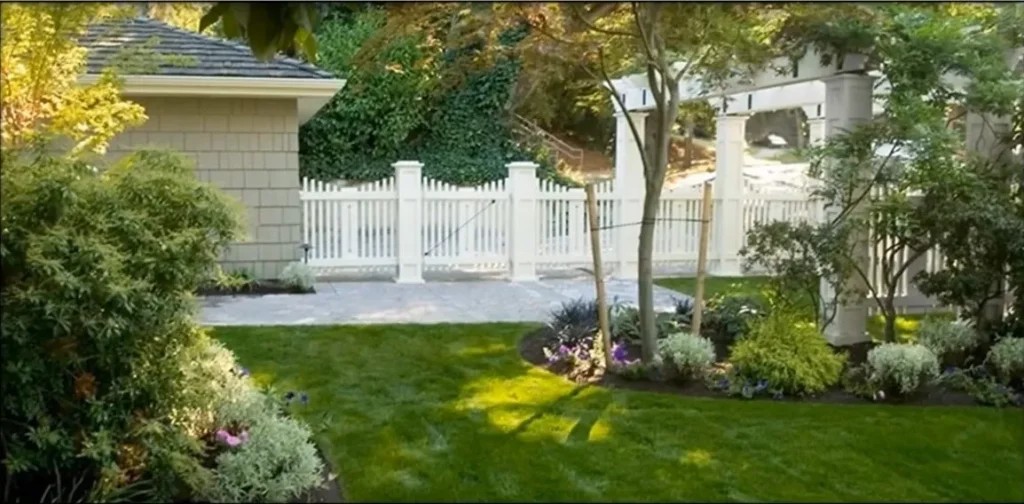
3) Phases of landscape elements
Landscape design involves the arrangement of a wide range of elements. The elements include two phases.
- Construction phase
- Hard areas
The Construction phase contains
- Topiary
- Fountain
- Edging
- Patios
- Ponds
- Arches
- Rock garden
- Pergola’s
- Trophy
Hard areas are
- Drives
- Paths
- Steps and Slopes
- Fencing walls
4) The Construction phase contains
i) Topiary
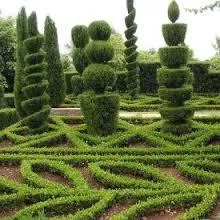
- Topiary is an art of shaping a hedge in ornamental forms and figures
- Topiary is a plant which is trimmed and clipped into ornamental shapes such as cone or bird or animal, or sometimes human figures
- Shrubs with busy habits are suitable for topiary works
- Casuarina, cupressus and bougainvillaea etc., are suitable for topiary work.
- These shrubs withstand frequent trimming and bending to form definite shapes.
- Continuous pruning is required
- The plant selected should be capable of being moulded to such shapes.
ii) Fountain
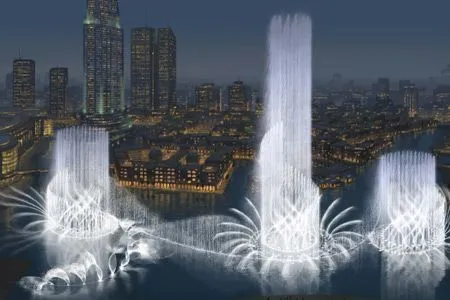
- Fountains are usually connected to springs or aqueducts. Until the 19th century moist fountains operated by gravity, and needed a source of water higher that the fountain.
- By the end of the 19th century as indoor plumbing became the main source of drinking water, urban fountain became purely decorative.
- Mechanical pumps are used instead of gravity and allowed fountains to recycle water and to force it high into the air.
- King Fahd’s Fountain in Jeddah, Saudi Arabia, The World cup Fountain in the Han-gang River in Seoul, Korea, The Gateway Geyser at Missouri, The Port Fountain in Karachi, The Dubai Fountain are the tallest fountain in the world.
- Main purpose of fountain in olden days was to provide water for drinking, bathing and washing.
- In addition to provide drinking water, now-a-days it is used for decoration
- Fountain is constructed with rock garden and small irregular pool with attractive water plants will give additional beauty.
- The various types of fountains are splash pad, musical and drinking fountain.
- Even marble fountain can be purchased in order to bring out the natural appeal of a pond or garden area.
iii) Edging

- Plant edgings are no longer popular as they are difficult to maintain.
- A row of bushes planted together along the sides of foot path is known as edge
- Landscape edging is the permanent one usually divides the areas from the foot path
- Alternanther with its bicolour leaves make very attractive and neat edging. It is also effectively used for lettering or carpet bedding.
- Dwarf plants are suitable for edging (eg) Eupatorium, plumbago etc.
- Clean and crisp lines between beds are created by edging.
- The materials used for landscape edging are….
- Lawn and garden divider
- Mowing strip
- Mulch capture
- Beauty edge

- Clearly contrast colour with surrouding foliage and flowers are suitable for edging. For more formal beds and edging, use uniform materials.
- Brick, plastic, concrete, wood, stone, and wattle are also used as edging materials.
a) Brick
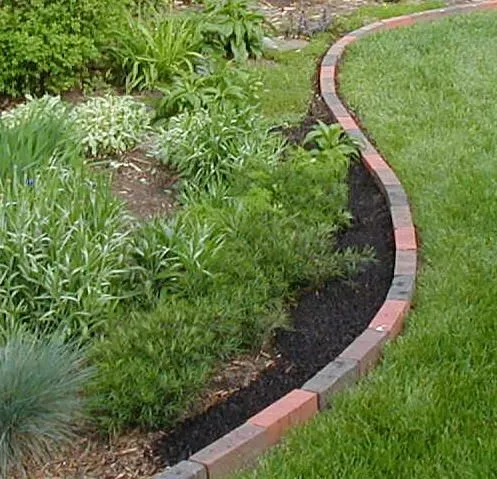
- Elegant and long-lasting, brick comes in a different of styles and creates uniform look.
b) Plastic

- Affordable and easy to install due to its flexibility plastic edging comes in many grades. It is less expensive.
c) Concrete
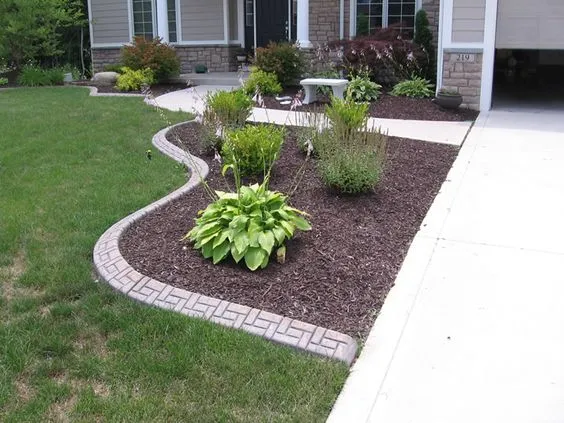
- Concrete edging are ready to be set in place, can make a simple form and create a custom edge.
d) Wood

- Affordable and easy to work with in straight lines, wood adds an informal organic look.
e) Stone
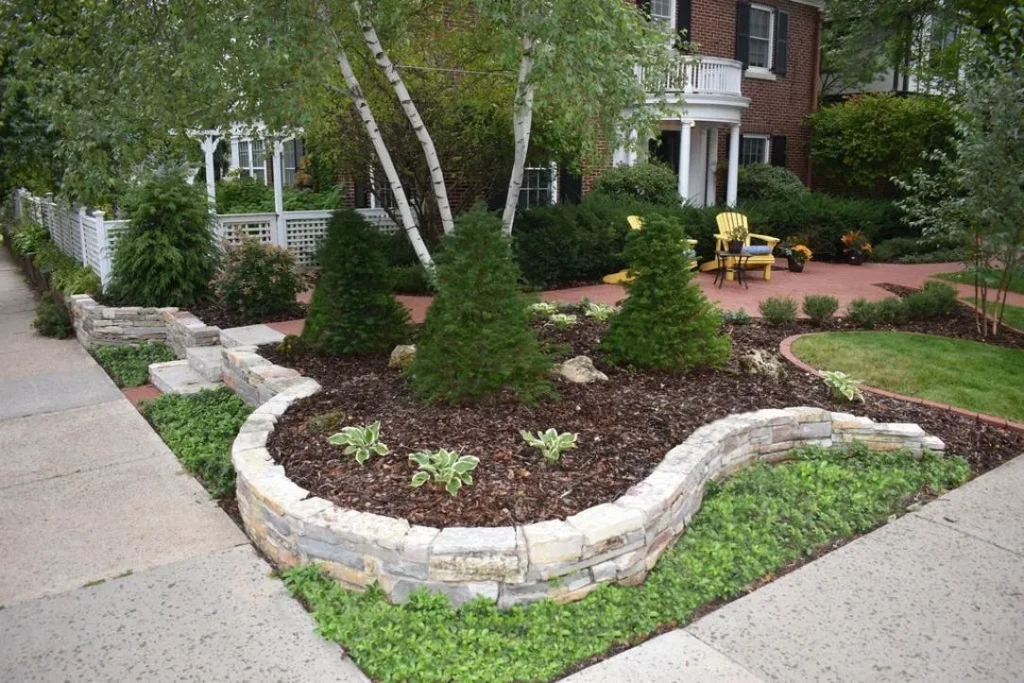
- One of the more versatile edging materials, stone can be carefully set in mortar for refined look or placed more casually for a relaxed appearance.
f) Wattle
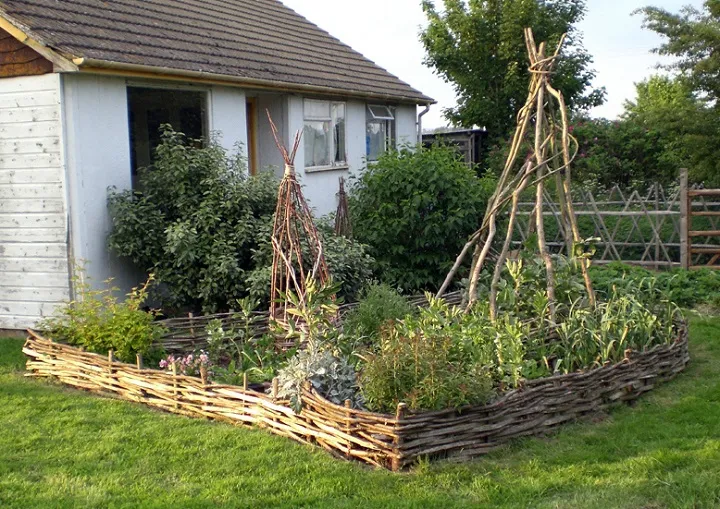
- This edging uses a technique that involves weaving saplings of pliable wood such as willow or dogwood, into a low fence. Wattle works well for holding back mulch.
g) Uses of landscape edging
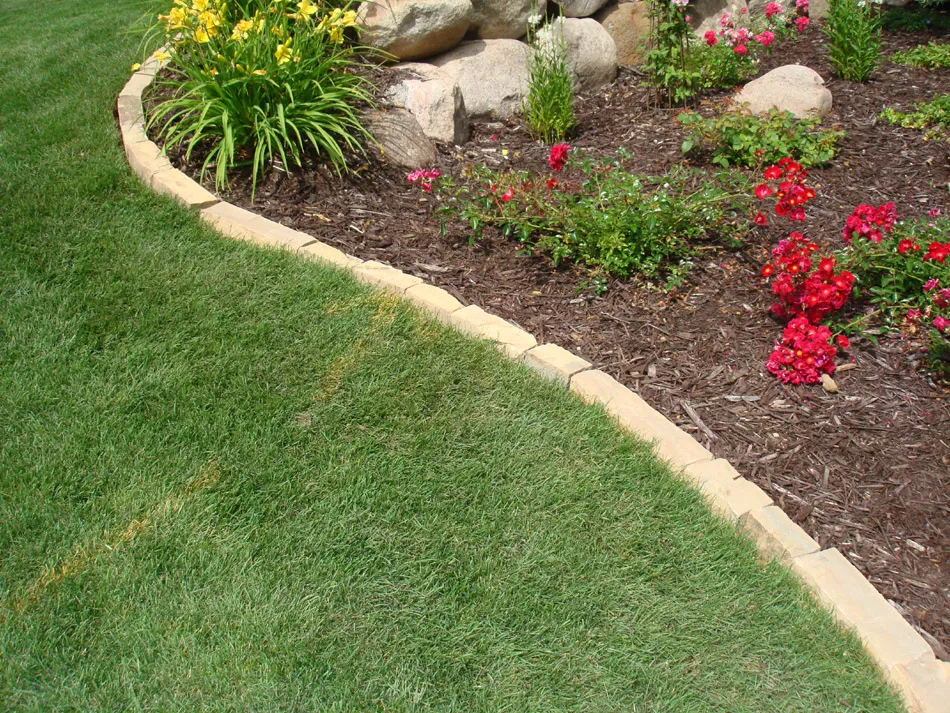
- Edging creates clear and definite lines between beds and other areas.
- Landscape edging can define a flower border, a shrub bed, fountain, ponds, lawn, pathways and soon.
- It helps the turf grass from spreading until root system is formed.
- Edging can facilitate garden traffic clearly.
- It prevents spilling of soil or mulch from the garden to lawn, flowerbed, carpet bed and other areas.
iv) Patios

- It is a outdoor space generally used for dining or recreation that adjoins a residence and is typically paved
- Concrete or stone slabs are mainly used for construction
- Bricks, block paving, tiles or cobbles are also used
- Front and back patios are favourite spots to relax in the warmer month
- Planting attractive plants around the patios will create peaceful environment to the viewers.
v) Ponds

- Pond can be very personal and charming. In India, it is one of an ancient art.
- Pond is a small body of still water formed naturally or by artificial means.
- Ponds with attractive aquatic plants create a beautiful effect in landscape
- Marsh plants and moisture-loving plants are grown in and around the ponds.
- Ponds provide for cultivation of water plants, marsh plants and moisture loving plants.
- Water lilies are colourful and some of them are fragrant also.
- The right depth for the water lilies is essential
- Those which grow at shallow depth are more delicate
- Some of the popular water lilies are Nymphaeacapensis, N-lotus, N-pubescens, N.rubra
- Lotus, known as water bean is a beautiful flower and is also popular because of its use for religious function.
- Lily pond is the best example. In this pond lily or lotus are planted.
- The shapes may be rectangular, square, round, oval, hexagonal or kidney – shaped.
- Marble can be used to create signs, around or in garden ponds
- Ceratophyllum, Elodea, Read mace, Umbrella grass, Lemna may be suitable plants for formal ponds.
- Potted plants like Balsam, Phlox, Table rose, Zinma may be kept in rows around the pond to attract viewers.
- The marsh plants may include Arumlitycyperus and certain Irises,Perinnials are creating beautiful effect around the ponds.
- Moisture loving plants in well drained positions may be Alocasia, Anemone, Colocasia, Red-hot pocker planted in and around the ponds.
- Ornamental grasses and bamboos also look pretty by the water side.
vi) Arches
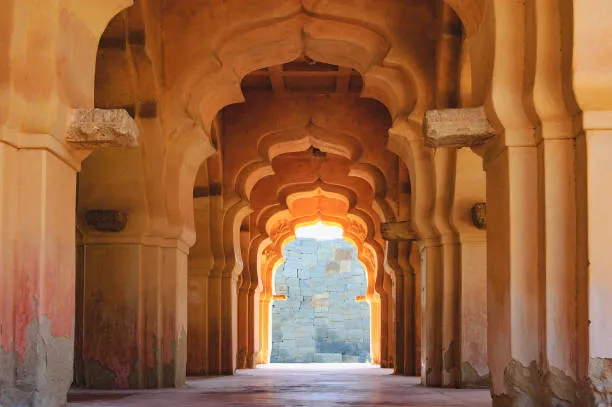
- The curved structure that forms a gateway for the garden is known as arch.
- Arches were used in formal gardens for centuries.
- Arch creates romantic link between two areas in the garden
- Garden arches acted as centre piece in landscaping
- Arches are constructed by p.v.c. plastic, steel, timber, vinyl, cedar wood, wrought iron, and aluminum
- Climbing roses, vines, flowering plants that have climbing in nature are planted in arches.
- Arches provide welcoming invite and add charming effect.

- The arches are mainly constructed in the places of entrances, pergola areas, patio areas, pathway, pool areas etc.
vii) Rock Garden
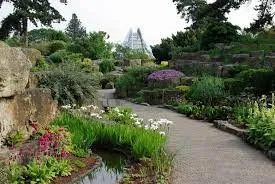
- A rock garden means an arrangement of rocks with plants growing in the crevices,.
- It brings the feel of the hills and a refreshing feature.
- Gardens established in areas where the soil is few millimeters in thickness and rock is exposed at many places are rock gardens.
- Other names of rock garden is rockery or alpine garden
- Alpines means the plants which grow in rocky positions at high altitudes
- Rocks, stones and boulders are the main characteristic features of rock garden.
- The stones help the plants in retaining their moisture and keeping their roots cool. They also protect them from heavy rains, frost ad wind and provide good drainage.
- Large open space or under the shade of the tree is suitable for rock garden.
- Irregular sizes for large stones are dumped with required peaks and slopes on all sides.
- Then the gap between rocks are filled with cultivated soil.
- Different variety of attractive plants are grown in the soil.
- Shrubs, herbaceous plants, creepers, ferns, cacti and succulents are some of the plants suitable for rockery garden.
- Construction of fountain at one peak and a shallow pool with beautiful water loving plants may include additional beauty to the rock garden.

- Japanese’s rock garden also known as a zen garden have the special features like moss, pruned trees, bushes, water pool and very few plants.
a) Care and Maintenance

- Thinning is done periodically
- Weeding is done by manually
- Manuring and fertilizing must be added regularly.
- Proper watering system should be followed.
- Diseased leaves should be removed immediately
- Frequently removed dead leaves and shoots.
viii) Pergolas
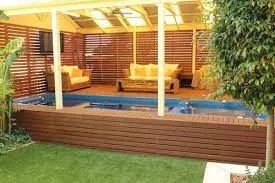
- Pargola is a one of the important garden feature forming a shaded walkway, passageway.
- It also forms sitting area of vertical posts or pillars that usually support cross-beams and a sturdy open lattice.
- Pargola protect open terrace
- Pergolas that not attached to a home or other structure is called as free standing pergolas. These pergolas are mainly used as sitting area.

- It comprised of many pillars and a roof of climber. Pillars are placed on both sides of the walkway.
- Curved steel rods are fitted above the pillars.
- Attractive climbers and creepers are planted and allowed to grow over the roof.
- Pergola gives basic structure for climbing the plants.

- Attamandacatharttca, Antigononlaptopus, Bougainvillaca, Jasmine, Passiflora are some of the beautiful flowering plants grown on the pergola.
ix) Trophy

- Arrangement of potted plants in the garden is known as trophy
- Usually attractive foliage and flowers are placed around the trees or a large object or statue.
- Trophy emphasis the particular object or statue in beautiful way
- Potted plants are arranged in different tier around the statue.
- Flowering annuals and herbaceous perennials are suitable for trophy arrangements.
5) Hard areas
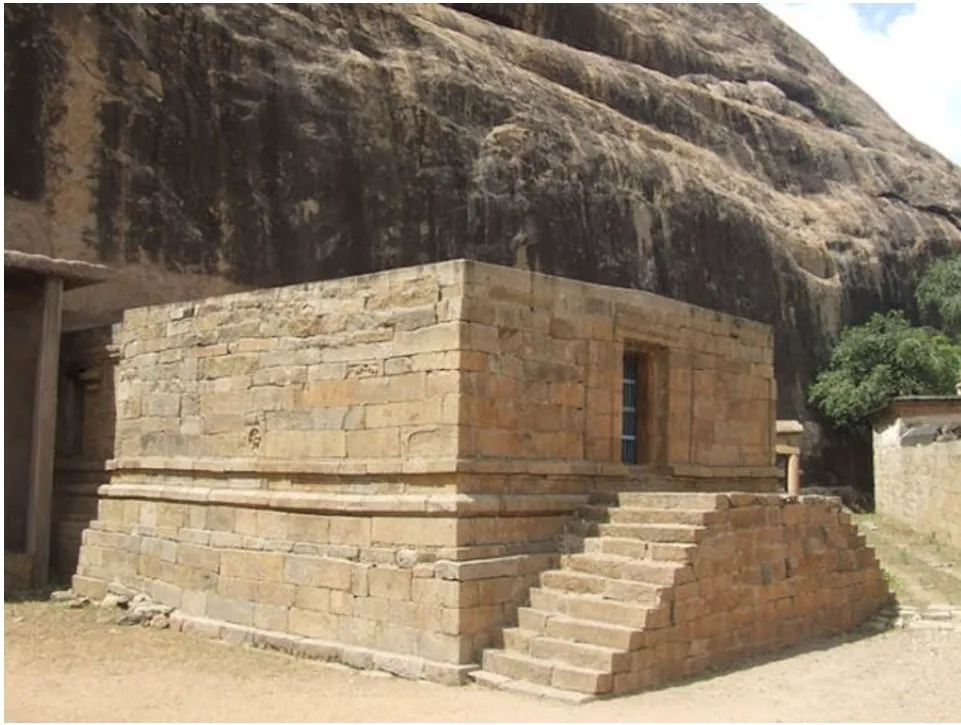
- The second phase of landscape element is construction of hard areas. Hard areas are also referred to as hardscape.
- Hard landscape or hardscape consists of the in animate elements of landscaping. They are hard and unchanging, although they may be movable and adaptable to the environment.
- Hard landscape is non- living elements of landscaping. They are dull, tough, hard and unchanging. They have some impact on soft landscape.
- In general hard landscaping is the construction of physically hard materials to make architectural features in the garden areas such as paths, walks, fences, pergolas, patios, decking, water features, walls, outdoor ‘rooms’ gazebos and so on.
- The most important elements involved in hard areas are….

- Drives
- Paths
- Steps and Slope
- Fencing walls
- Garden path, drives, steps and slope beside being functional in providing suitable surface to walk upon, can be a piece of beauty and an architectural feature in itself.
- They should be as few as possible, and should run from one point to another direct in a few bold, graceful and gentle sloping curves.
- Materials available lovely may be used without sacrificing originality.
- Whatever be the material, size and design, the path should merge in the surroundings, should be smooth to walk upon and should not get slippery, particularly in the rainy season
i) Drives
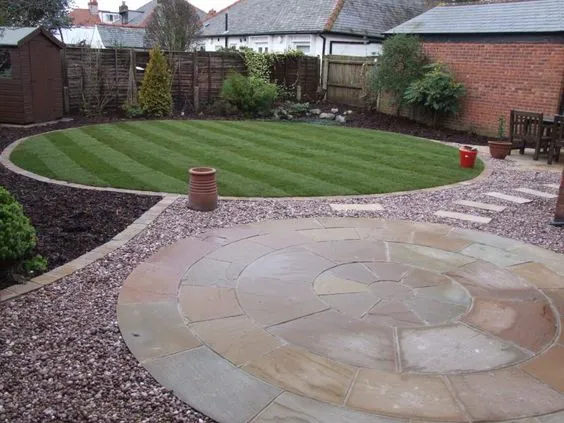
- Drives or roads are an important part of gardens, which protect garden plants from foot steps
- Drives should have link from one part to another part.
- Brick, gravel, rock or stone, concrete timber, bitumen, glass, metal are used for constructing drives.
- Sometimes the inter spaces can be planted with ground spreads
ii) Paths

- A garden path, besides being functional in providing suitable surface to walk upon can be piece of beauty and an architectural feature in itself
- Paths define the passage in the landscape created
- Paths may be paved or unpaved.
- Paving materials are used to reduce the demerits of mud and dust
- Paths facilitate easy circulation
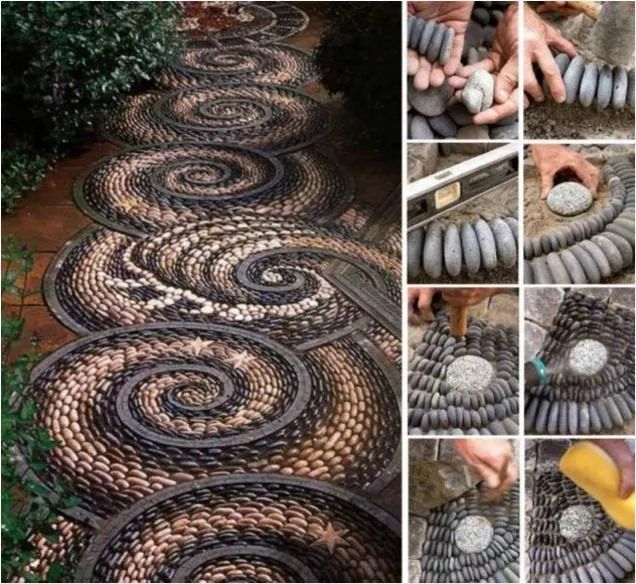
- Various design pattern of pathing materials are used to create beautiful and charming effect of the garden
- Paving materials could be natural or man-made
- Man-paving materials are available in various colours and texture
- Stone, brick, concrete, stacked stones, pebbles, marble are used as paving materials.
- Decorative stones are used in pathways or trails to beauty the garden

- In formal gardens irregular shaped flat stones or tiles are used for paving. This is called as crazy path.
The type of paths are…
a) Brick path
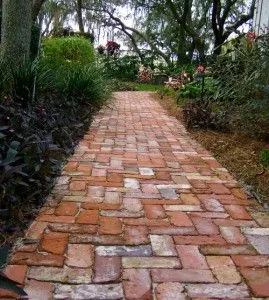
- Bricks arranged as in the walls have the formal effect. They may look attractive in an informal setting also.
- But better would be broken bricks joined together in irregular shapes, this will be cheaper too.
b) Stone path
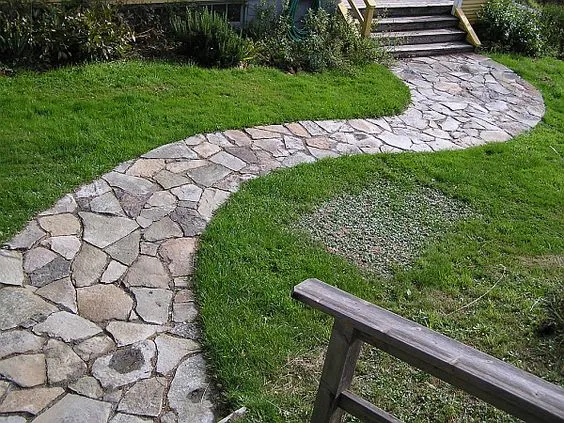
- Stone are available in many natural hues, in regular as well as irregular shapes, and created delightful effects.
- River stones make good & crazy paving and they are imbedded in the soil or earth stones can be substituted by mortar rubbles in irregular shapes
c) Coal paving’s
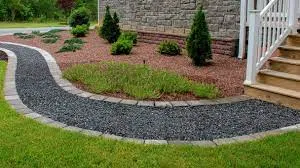
- In areas where coal is available in plenty, coal paving can be unusually attractive and functionally effective.
d) Gravel Path

- Small boulders topped with red gravel beaten firm can also make an attractive garden path.
- Perennial grasses may be grown in between the stones to increase the beauty of formal garden.
iii) Steps and Slope
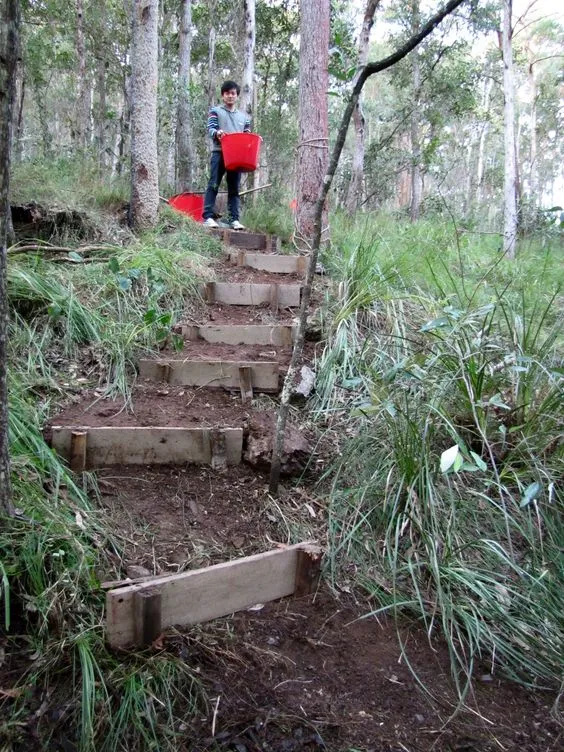
- Steps and Slopes in the landscape garden have the practical function of allowing easier access over sloping ground.
- Steps and Slopes facilitate vertical circulation
- Steps have ornamental function of the garden.
- Placement of one or two steps can lend great character to a garden
- The materials used for steps should match the location
- Simple log-steps suit a woodland garden and cut stone slabs for formal garden.
- Land sliding should be taken into consideration whilecreatingslopes
- For safety point of view the steps Tread – 30cm, Risers – 10cms.
- Steps always constructed by non-slippery materials.

- Now-a-days flagstone is used for consuming steps
- Pebbles are used for sidewalks
iv) Fenching walls
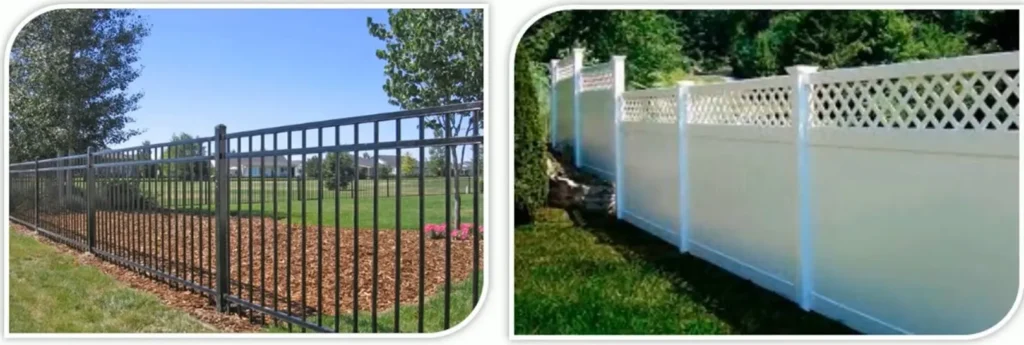
- To protect some important elements in landscape the landscape architects construct walls and fences around the plants
- The type of fencing use are wrought union fence, vinyl privacy fences.
- A stacked stone retaining wall can perform both decorative and protective effect.

- Bamboo fencing is renewable source and create a natural look.
- Stone in landscaping is an important hardelement that evoke strength and security. Stone are mainly used to remain walls
- Retaining walls is constructed around a small pond or even a garden

- Flagstone is a very popular choice used for simple ornamental design
- Boulders are also used for creating decorative effect of the garden. The important flagstones are birchwood, wisconsin, granite and honeycomb western stone.
6) Functions of hard landscape

- Create link between buildings
- Enclose space
- Create a theme
- Define private areas
- Serves the vehicular movement
- Facilitate easy movement of disabilities
- Visually link a development with its surroundings.
7) Choosing Hard Landscape Materials

- Materials selected for constructing hard areas not only for their appearance but also for their ability to withstand the use to which they are being put Materials should be durable, easy maintenance, good quality and durable.
8) Conclusion
- Landscape is a place where ornamental plants are grown mainly for people to enjoy and relax.
- Different plants in the garden are grown in an ordered manner to attract the people, so landscape design involves the arrangement of wide range of elements.
- These elements are used to create a beautiful landscape design.
- It provides the recreation of people and improve the environmental quality.
- Landscaping needs skill and an aesthetic sense of creativity.
- Careful planning is therefore essential for developing and maintain a beautiful garden.
- For creating landscape design great professional skills and strategic planning are important phenomena.
Each of these elements plays an important role in creating the overall character and beauty of a landscape. The way these elements are arranged and combined can have a significant impact on the visual appeal and functionality of a landscape.
Loved this post! The integration of natural elements in landscape design really transforms spaces. The examples you provided are inspiring and showcase the beauty of thoughtful landscaping. Can’t wait to see more posts like this!